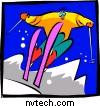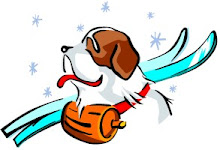
September 25, 2005
Lots of Choices, Lots of Room on French Slopes
By BILL PENNINGTON
THERE was something missing.
Maybe it was the view, shrouded by a brief snow squall that would promise good snow cover in every direction. Maybe it was the other people in the gondola, because there weren't any. Maybe it was the lack of obtrusive boundary warnings or glaring trail indicators in the vast swath of snow below. Instead, there was just a wide open welcome.
Ascending the Saulire lift nearly 3,000 feet above the Courchevel ski resort, there comes a moment when you realize what it is that's missing from your trip to this centerpiece of the Trois-Vallées (three valleys) region of the French Alps.
It's the pressure to make the right choice.
Which trail? Come now, there are 360 miles of trails in the three valleys.
Where to find the secret stash of off-piste skiing and riding? There are more than 28,000 acres available, too immense to be anyone's secret.
Which lift avoids the crowds? There are more than 180 lifts in a network serving terrain that is more than three times larger than the biggest North American resorts. Crowds, such as they are, scatter.
Where to stay? With five distinct villages, there is no single best location. The Courchevel villages are separated by elevation and economics, providing hotels for every budget taste.
Where to eat? You must be kidding. The nearest ski lodge cafeteria with chicken fingers is probably in Maine. Superb restaurants rise between the mountain peaks like epicurean mirages. Sixty more dining options grace the village streets.
No, standing atop any of the peaks surrounding Courchevel - Italy over one shoulder and Switzerland over the other - the calm that envelops you is the understanding that there is no stress to choose wisely.
The choices are everywhere. All may not be equal, but you will not be burdened long for any improvident decision. The next best choice is right around the corner.
This has something to do with the sheer size of Courchevel and the vast Trois-Vallées area, in the Savoie region of southeastern France. The Trois-Vallées is home to one of the largest ski lift and trail networks in the world. On a routine ski day in Courchevel, you head over one mountain, perhaps crest another, and then barrel your way into the valley of yet another, different resort. It will likely be five to six hours before you head back to your home base.
Of course, that's your choice. You can also step out of one of the dozens of hotels with access to the slopes and almost never lose sight of your room's balcony. The mountain and lift network right out your door will be roughly the size of an average Eastern ski area in the United States.
Courchevel's variety applies not just to its skiing and riding. One of the things that separates Courchevel from other resorts is that it has built its villages at various elevations - on striking, stepped plateaus. The villages are named for their elevation in meters, and each has characteristic differences. The pace of life seems to quicken with the altitude.
Courchevel 1300, also known as Le Praz, is small, quaint and quiet, attracting many families. At Courchevel 1650, there are more storefronts, bars and a greater variety of quality hotels, with more middle-income vacationing couples and small families. At the top of the spectrum, in every way, is Courchevel 1850, a stylish, woodsy enclave of pricey shops, haute cuisine and chic gathering spots.
Still, at any elevation - a simple family hotel at Courchevel 1300 or an exquisite chalet of 10 suites at Courchevel 1850 - you can hop on a gondola that serves all the same skiing or riding terrain. The villages are also linked by road and a bus system.
Everyone is connected and independent at the same time, from budget-minded travelers to European celebrities, although keeping within your budget will be a challenge - the charge for most goods and services is steep. This is especially true at Courchevel 1850, a mecca for the Paris jet set, who fly directly to an adjacent, small village airfield for private planes. They are drawn to the spas and to narrow streets that offer an old-world, yet privileged, shopping experience. In Courchevel 1850, places like Aspen are not considered competitive rivals.
As Eric Tournier, one of Courchevel's prominent hotel and restaurant owners, said: "Tell me another place in the world that can match our skiing terrain in dimension and variety, that has the quality of food in our restaurants and the depth of upscale private hotels? There is no such place."
Mr. Tournier did not even mention the discos that pulse until the wee hours.
In fact, it was the late night crowd that made my visit to Courchevel particularly pleasant last winter. Not that I danced with them. While they slept the next morning, I was out on the ski slopes.
Unlike most American winter vacationers, who tend to be early risers, the skiers and snowboarders in the French Alps tend to wander out to the slopes around 11. My wife, three children and I felt odd charging through our hotel lobby just after 8:30 a.m., skis in tow, especially since all our fellow guests were leisurely reading newspapers or finishing sumptuous breakfasts.
But there was a payoff for our fervor - endless choices. We could ski anywhere unimpeded.
There is so much to choose from, however, that we knew we would need an instructor as a guide on the first day. My wife, Joyce, and our 6-year-old son, Jack, stayed close to our lodging in Courchevel 1650, the Hotel Portetta, where an inviting sun deck borders some of the gentler terrain.
I took the more adventurous tour with my two teenage daughters and Philippe Mugnier, a lifelong Courchevel resident, ski teacher and town councilman. Mr. Mugnier wasted no time whisking us to the highest peak overlooking the Courchevel valley. It meant riding five lifts with rapid descents in between, but the snow on trails like Aiguille du Fruit and Vizelle was comfortable, mostly soft packed powder with a top dressing of new snow. More important was the freedom to roam on most trails, which were more like guideline paths in a broad snowfield rather than alleys confined by trees, ropes or cliffs.
I don't know which was more exhilarating - the freedom, the conditions or the fact that it seemed as if we were the only people awake and on skis - but we raced from lift to lift. Once we reached the top, we pointed our skis over the crest away from Courchevel and dropped into some deep powder runs toward the village of Méribel, where the 1992 Winter Olympics women's alpine skiing events were held. It was more than 1,000 yards down to Méribel, and the snow depth meant a slower pace.
We stopped for a quick snack of cured meats like ham and dry sausages and a local cheese, Beaufort. With delicious coffee to linger over, we might have eaten more, but Mr. Mugnier suggested that we stay less than sated. We were heading over another peak, and into the next valley.
Farther west are the villages of Val Thorens and Les Menuires, excellent starting points for off-piste and backcountry skiing, although again, guides are recommended because of the danger of avalanches, and we did not venture too much beyond the traditional trail map. Eventually we worked our way back toward Courchevel, and, stopping near a helipad at the base of the Suisses trail, clicked out of our skis outside Le Cap Horn, a large chalet-style restaurant with a wooden sun deck larger than would be found on an ocean liner. Inside there was white linen on the tables, waiters in tuxedos and music accompaniment.
In the Trois-Vallées, there are no midmountain cafeterias, the familiar midday stop for North American skiers. There are no places to stop for a quick bite to eat. Fast food would be considered a homemade crepe of your own design. In the French Alps, luncheon reservations, which the average American skier might find a bit of a nuisance, are a near necessity for on-mountain dining. But take a seat for lunch at one of several French mountain retreats like Le Cap Horn, and it will all seem worth it.
The seafood buffet was varied, fresh and inventive, the steak tartar uniquely seasoned and the desserts so rich that afterward, serious skiing was out of the question.
Back outside, we traversed the last few hundred yards slowly and happily.
There was still time to join Joyce and Jack, who had had their own full day of skiing, on the Hotel Portetta sun deck with a bottle of local Savoie wine.
Subsequent days were similar although we made more time to amble through the villages. We learned to spot groups of instructors getting off duty, and to follow them into restaurants.
There was also time for sledding on a specially built 1.25-mile sled track that runs from Courchevel 1850 to the village at Courchevel 1550. This doesn't remind you of the Flexible Flyer dash down the hill in your local town park; it has switchback turns.
Day by day, though, there was less zeal for speed. There was no getting away from the plentiful skiing prospects, but you can only pass so many people lounging in the hotel lobby by morning or sunning themselves in the afternoon without wondering what they know that you do not.
Were we missing something?
Under no particular pressure, we made a decision. Mornings were still for skiing - somebody had to put all that good snow to use. Afternoons were for the sun deck.
Or, we could do it the other way around. Why choose?



